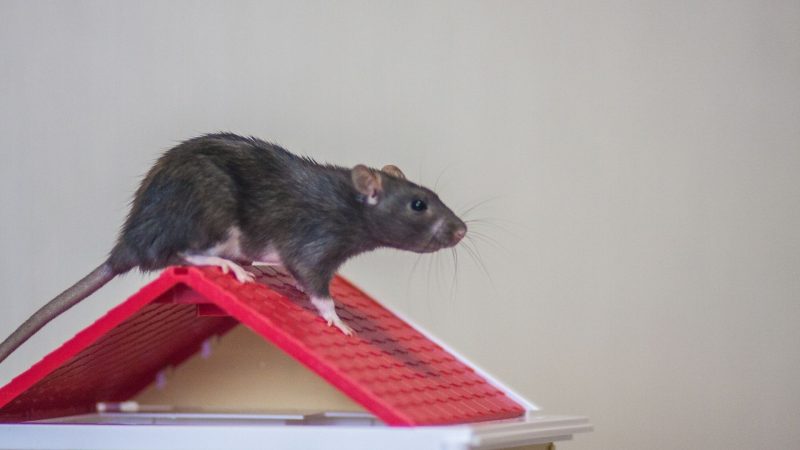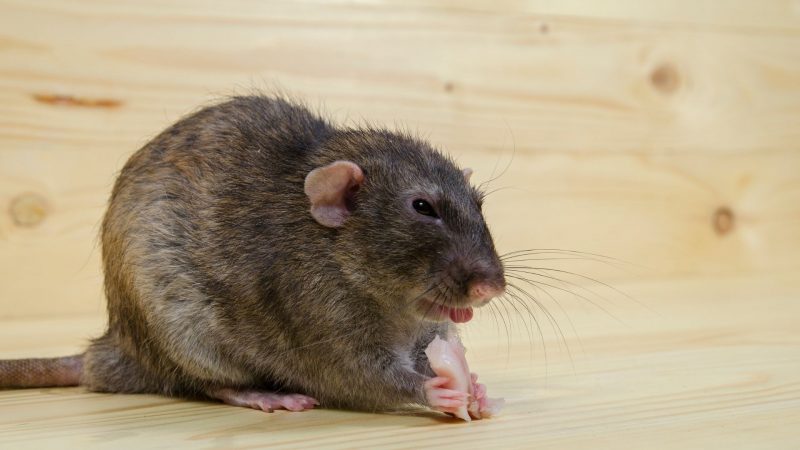Do you hear some noises in your ceilings, attic, and walls? Unfortunately, this may be a sign of roof rats’ presence, and it can be disturbing to hear their noises and movements, especially at night. These rodents can enter your house through gaps or spaces, and they can quickly multiply. How do you get rid of roof rats, and what are the ways to prevent them from invading your home?
How to get rid of roof rats? To eliminate roof rats, you can use electronic devices, snap traps, repellants, or home remedies. Be sure to seal all spaces and gaps, and remove any possible breeding sites and food sources. Always keep your house clean.
Keep reading to learn more about the various ways of getting rid of roof rats from your attic, walls, and ceilings. You will also know how you can prevent roof rats from nesting in your house.
What Are Roof Rats?

Roof rats are also known as ship rats or black rats and are smaller than Norway rats. They usually live in the upper portions of houses or buildings; hence, this is how they get their name. Aside from damaging the materials in your house, roof rats can also cause harmful diseases and can contaminate food.
What Do Roof Rats Look Like?
Roof rats have pointed noses, big eyes and ears, and flaky tails. Their bodies are long and thin; they have soft and smooth fur that is either black or brown. These rats’ undersides could either be black, gray, or white. They weigh between 5 to 9 ounces and have a length of 6 to 8 inches, excluding their tails which measure 7 to 10 inches.
Where Do Roof Rats Come From?
Originally, roof rats came from Southeast Asia, but now they can be found all over the world, specifically in tropical regions. Generally, roof rats live in colonies and prefer to nest in the upper portion of houses or buildings such as ceilings, rafters, and attics. However, you can also find them in piles of wood or around structures.
How Long Do Roof Rats Live?
Commonly, the lifespan of roof cats is about one year. Most often, female rats outlived the male ones. However, their life could be shortened by predation or pest control methods.
What Do Roof Rats Eat?

Roof rats are also known as food hoarders and like to eat nuts, fruits, grains, seeds, and meats. Although these rodents are omnivorous, they will eat anything available to them.
What Is the Difference Between Roof Rats and Norway Rats?

Roof rats are thinner than Norway rats. The tails of roof rats are longer, while Norway rats have shorter tails. Roof rats have pointed noses, while Norway rats have rounded noses. Norway rats are commonly found in basements since they are not great climbers, while roof rats invade the upper levels of houses.
What Attracts Roof Rats?
Generally, roof rats prefer covered shelters, particularly in higher places such as ceilings and attics. However, they are also attracted to fruit trees, vegetation, and shade. That is why you can also find them in storage boxes, piles of wood, or shrubbery.
How Do Roof Rats Get In the House?

Roof rats can easily enter through tiny holes. They can also work their way through gaps, entry holes, cracks, and crevices. Roof rats prefer to nest in higher places, so most often you can see them climb on wires, telephone lines, or trees.
How Do You Know If You Have Roof Rats in Your Ceiling or Attic?
If you hear any activity in your ceiling or attic, then there is a possibility that these are roof rats. Most likely, you will hear gnawing and scurrying in your ceiling or attic, especially at night. Typically, this will happen when the weather starts to cool down. If you can hear a lot of noise during the day, then there might be a large population of roof rats using your attic.
Odor is another indication of roof rat infestation. This is because they will use your attic as their bathroom, and this smell can be noticeable. Also, they will leave some stains on the walls. You might also notice that the insulation in your house is torn apart.
Are Roof Rats Dangerous?

The following section will examine whether roof rats are a threat and what problems they cause.
Do Roof Rats Carry Diseases?
Yes. Roof rats can contaminate stored food with their feces. They can transmit diseases through their saliva, urine, and feces, as well as through their bites and the infected fleas from their bodies.
What Diseases Do Roof Rats Carry?
Roof rats can transmit various diseases to humans, including plague, leptospirosis, rat-bite fever, salmonellosis, and typhus. Physical contact with roof rats can put you at risk for rat-bite fever. Infected fleas from roof rats can cause typhus and plague. In addition, consuming food or water contaminated with their feces or urine can cause salmonellosis and leptospirosis.
Can Roof Rats Cause Fires?
Aside from being dangerous due to disease transmission, roof rats can also cause serious damage to your house. They can chew electrical wires and get them exposed. As a result, this could get in contact with other materials and could ignite a fire.
How Do You Get Rid of Roof Rats?
To get rid of roof rats, you must do the following:
- Figure out how they get inside your house. Seal any cracks, gaps, spaces, or holes, and make sure that your vents and windows are screened.
- Trim down shrubs and trees.
- Clean up any potential food sources such as fruits fallen from trees.
- Keep your home clean, particularly in nesting sites such as under the fridge, cupboards, and the stove.
- Eliminate any piles of wood or debris.
- Keep your garbage tightly covered.
- Store dry food and pet food in sealed containers.
- Avoid leaving pet food outside.
- Remove any outdoor sources of water, including birdbaths, leaky sprinkler heads, etc.
- Use snap traps, electronic devices, or a mixture of bait and poison to get rid of roof rats.
How to Get Rid of Roof Rats Naturally?
The effective way to remove roof rats is to use a chemical to eliminate them. However, you can get rid of them naturally through the following:
- Let your dog or cat chase the rats away.
- Use humane traps to catch rats and release them a few meters away from your house.
- Place mothballs or cotton balls soaked in peppermint oil near entry points.
- Keep your home and yard always clean.
- Eliminate their hiding places by reducing any clutter.
- Keep grains and pet food in sealed containers.
- Remove any potential food sources and nesting areas.
- Trim down bushes and trees.
- Seal any small cracks and crevices.
- Remove pet food in the yard.
- Get rid of bird feeders.
- Place your garden far away from your house.
- Plant lavender and mint in areas where rats frequently stay.
- Spray peppermint oil or eucalyptus oil in your yard.
- Install an electronic rat repeller.
- Rat-proof your pipes by painting them with smooth, high-gloss paint to prevent them from scaling on your drainpipe.
- Paint your house with high-gloss paint to prevent them from climbing on walls.
- Keep your compost pit far away from your property.
Home Remedies to Get Rid of Roof Rats

Killing rats with poison can be messy and dangerous to pets or children. To avoid this, you can try using natural rat repellents below:
- Dip cotton balls in peppermint oil, castor oil, or citronella oil, and then spread them in roof rat-prone areas such as roofs, attics, rafters, etc.
- Place mothballs in the attic, ceiling, kitchen, basement, yard, or other areas where there are rats present.
- The smell of ammonia can also keep the rats away. Mix ammonia, water, and detergent in a bowl and place it in the infested area.
- Put slices of onions and garlic near the holes where you’ve seen the rats.
- Sprinkle pepper flakes or instant potato powder around the hiding places of the rats.
How to Get Rid of Roof Rats Without Killing Them?
To get rid of roof rats without killing them, you can do the following:
- Use humane traps or snap traps, then release rats far away from your home.
- Practice rat-proofing measures such as covering your trash cans with a lid, using glass or metal containers in storing food, installing window screens, and sealing cracks.
How Do You Know When All the Roof Rats Are Gone?

The best way to know if there are no more roof rats in your house is if you can’t find their feces anymore. Check for their droppings inside the cabinet, under the fridge, or in any hidden areas.
To determine if they are completely gone, you can do some tests. For instance, leave some biscuits outside, and if it’s gone or have been nibbled, then rats could likely be the culprit. You can also spread talcum powder or flour on surfaces where you suspect the presence of rats. If you find a trail of footprints, then there are still rats inside your house.
Related: Rat Control: How To Get Rid of Rats?
List of Sources
Gouge, D. H., et al. (2018). Roof Rats: Pathogens and Parasites. The University of Arizona – Cooperative Extension.
Timm, R. M., et al. (2011). Pests of Homes, Structures, People, and Pets: Rats. University of California, Agriculture and Natural Resources – Statewide IPM Program.
Controlling the Rat – A Community Effort. (2014). Department of Health, New York State.
Rodents. (2010). Centers for Disease and Control and Prevention.
- Bed Bug Surge 2025: How to Detect, Prevent, and Safely Eliminate Infestations in Top U.S. Cities - June 18, 2025
- Asian Needle Ants Invade US Homes: 2025 Guide to Identification, Risks, and Effective Control - June 11, 2025
- New World Screwworm Alert: How US Livestock Owners Can Prevent Outbreaks and Protect Herds [Summer 2025 Update] - June 8, 2025
